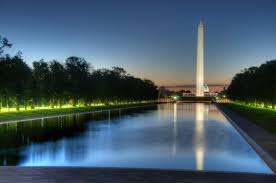Walls of Jasper: We have 300,000 square meters of wall to cover. Let's assume that each stone is 1 cm x 1 cm, or 0.0001 square meters. Therefore we need three billion stones to cover the wall. Double that for both sides of the wall. Fortunately, Jasper is cheap. At $2 per stone, give or take, the fancy walls end up costing us twelve billion dollars. (Also, your wall numbers aren't accurate, but it doesn't really matter - more on that later.)
Sea of Crystal: 681m x 51m is an awful number; I'll call it 700m x 50m, or 35,000 square meters. Therefore we need 350 million stones (at one square centimeter each) to cover it, half of which are emerald and half of which are topaz. Note: In researching this it seems that my square centimeter estimate is rather large for gems; as such, I'll be scaling prices accordingly rather than recalculate, as you only want a ballpark estimate anyway. Emerald would go for about \$400 per square centimeter, while topaz is about \$50 per square centimeter. Average it out, it'll cost \$225 per square centimeter, or a grand total of eighty billion dollars (approximately).
City of Gold: We need 400,000 square meters of gold foil. Amazon is currently listing gold leaf foil at \$50 for what works out to 0.15 square meters. Thus we'd need 2.7 million of them, so it would cost about 135 million dollars.
Giant Golden Statue: I was a physics major in college, so I'm going to do what physics majors do best and assume that the statue is a sphere. 13 meters across is 512 inches (since you put the gold thickness in inches). The volume of gold is then about 412,000 cubic inches. That converts to 4.2 million troy ounces of gold. According to the NASDAQ, 24 karat gold is currently going \$1250 per troy ounce, so our statue will end up costing us just a touch over five billion dollars. But wait! That's before the gem-encrusting. The surface area of our statue/sphere is about 827,000 square inches, or 534 square meters. The average gem price I've used so far comes out to \$150 per square centimeter, so I'll just use that. Assuming we only want to cover the statue about halfway (after all, if you cover it all the way you can't show off the gold below!), we're covering 267 square meters for a grand total of just a touch under five hundred million dollars. So all in all we're looking at a grand total of about five and a half billion dollars.
The Pearly Gates: Pearls have many different sizes; we'll say that the ones we're working with are one square centimeter (10 millimeters is a common size for necklaces etc, so that makes sense). The gates are about 50 square meters (12 * 5 is 60, take out some for the area you walk under). But wait! We have to consider the inside of the gates as well. Revelation says that the walls of the city are 72 yards wide (call it 70 meters because I'm lazy). Ballparking, the surface area of the interior of the gates will be about 800 square meters (we cut out basically a 5m x 2m hole for the gate, so about twelve linear meters, times 70 meters deep). Then we have to cover the other side of the gate as well, so a grand total of about 900 square meters, meaning we need about nine million pearls. But there are twelve gates, so we need 108 million pearls. Pearl necklaces are about a meter in length, meaning that they have about a hundred pearls on them. Estimating a thousand dollars per necklace, we get about ten dollars per pearl, so our gates cost us about 1.1 billion dollars.
All told, we're currently just under $100 billion. Slightly out of reach of Bill Gates, atop the list of billionaires, but they could team up and buy this pretty easily. That, coupled with the fact that you wanted the answer in terms of ratio to the US GDP, makes me think that this number is just too small to be the ultimate holy city for an omnipotent deity. So I went back to Revelation to see what else I could add to put this city beyond the wallets of mere mortals. And lo and behold....
The Streets Paved with Gold: Revelation 21:21 tells us that the streets are pure gold. Assuming this means that gold is replacing asphalt, we've got us a LOT of gold here. But first... how many roads are there? Well, a city block is about 100 meters. Revelation 21:16 says that the city "is laid out as a square... 12,000 stadia in length....". A Roman stadium was a distance of about 185 meters. So the city is 2.2 million meters in each direction (remember how I said your wall numbers were off? Yeah....). At that point we'd have 22,000 roads, going both crosswise directions, so 44,000 total. Call it 40,000 to account for double-counting the intersections. Roads usually have asphalt about six inches deep, call it ten centimeters or 0.1 meters. If each road is then ten meters wide, each road has a cross-sectional area of 1 square meter, times 2.2 million meters long, for a road volume of 2.2 million cubic meters, times 40,000 roads. We have a grand total of 88 billion cubic meters of gold in our roads. Gold has a density of about 19,000 kilograms per cubic meter, so our roads weigh about 1.67 quadrillion kilograms (for scale, WolframAlpha says that's about 20 times the total biomass on Earth). That converts to $5.38 * 10^{16}$ troy ounces, which comes out to 67 quintillion dollars. That's just under four million times the US GDP. Much more heavenly.





